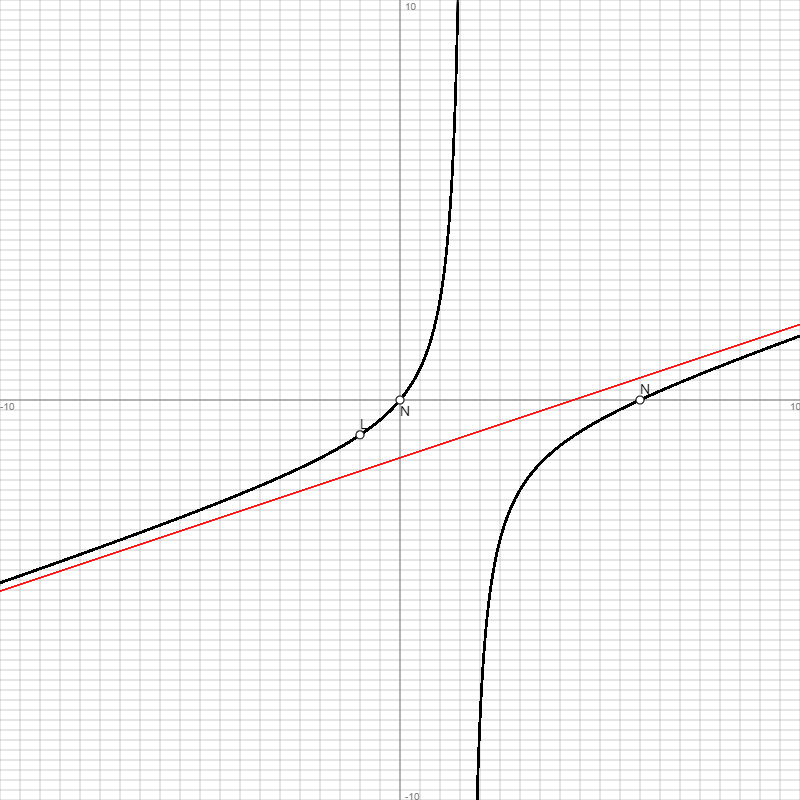 , Df = R\{-1; 5/3}, Wf = R, gebrochen rationale Funktion, x -> -∞: f(x) -> x/3-13/9 = y als Grenzkurve, x -> +∞: f(x) -> x/3-13/9 = y als Grenzkurve ->
, Df = R\{-1; 5/3}, Wf = R, gebrochen rationale Funktion, x -> -∞: f(x) -> x/3-13/9 = y als Grenzkurve, x -> +∞: f(x) -> x/3-13/9 = y als Grenzkurve ->www.michael-buhlmann.de
Funktion: f(x) =  , Df = R\{-1; 5/3}, Wf = R, gebrochen rationale Funktion, x -> -∞: f(x) -> x/3-13/9 = y als Grenzkurve, x -> +∞: f(x) -> x/3-13/9 = y als Grenzkurve ->
, Df = R\{-1; 5/3}, Wf = R, gebrochen rationale Funktion, x -> -∞: f(x) -> x/3-13/9 = y als Grenzkurve, x -> +∞: f(x) -> x/3-13/9 = y als Grenzkurve ->
| Wertetabelle: | |||||
| x | f(x) | f'(x) | f''(x) | f'''(x) | Besondere Kurvenpunkte |
| -10 | -4.5714 | 0.35 | 0 | 0 | |
| -9.5 | -4.3955 | 0.35 | 0 | 0 | |
| -9 | -4.2187 | 0.35 | 0 | 0 | |
| -8.5 | -4.041 | 0.36 | 0 | 0 | |
| -8 | -3.8621 | 0.36 | 0.01 | 0 | |
| -7.5 | -3.6818 | 0.36 | 0.01 | 0 | |
| -7 | -3.5 | 0.37 | 0.01 | 0 | |
| -6.5 | -3.3163 | 0.37 | 0.01 | 0 | |
| -6 | -3.1304 | 0.37 | 0.01 | 0 | |
| -5.5 | -2.9419 | 0.38 | 0.01 | 0.01 | |
| -5 | -2.75 | 0.39 | 0.02 | 0.01 | |
| -4.5 | -2.5541 | 0.4 | 0.02 | 0.01 | |
| -4 | -2.3529 | 0.41 | 0.03 | 0.01 | |
| -3.5 | -2.1452 | 0.42 | 0.03 | 0.02 | |
| -3 | -1.9286 | 0.44 | 0.05 | 0.03 | |
| -2.5 | -1.7 | 0.47 | 0.07 | 0.05 | |
| -2 | -1.4545 | 0.51 | 0.1 | 0.08 | |
| -1.5 | -1.1842 | 0.57 | 0.15 | 0.14 | |
| -1 | - | - | - | - | Lücke L(-1|-0.875) |
| -0.5 | -0.5 | 0.85 | 0.47 | 0.66 | |
| 0 | 0 | 1.2 | 1.04 | 1.87 | Nullstelle N(0|0) = Schnittpunkt Sy(0|0) |
| 0.5 | 0.7857 | 2.1 | 3.03 | 7.81 | |
| 1 | 2.5 | 5.75 | 16.25 | 73.35 | |
| 1.5 | 13.5 | 87 | 1040.04 | 18948.05 | |
| 1.667 | Infinity | Infinity | Infinity | Infinity | Senkrechte Asymptote/Pol x = 5/3 mit Vorzeichenwechsel: x -> -5/3-: f(x) -> +∞, x -> -5/3+: f(x) -> -∞ |
| 2 | -8 | 22 | -130 | 1163.03 | |
| 2.5 | -3.5 | 3.8 | -8.32 | 29.88 | |
| 3 | -2.25 | 1.69 | -2.03 | 4.56 | |
| 3.5 | -1.5909 | 1.05 | -0.78 | 1.28 | |
| 4 | -1.1429 | 0.78 | -0.38 | 0.49 | |
| 4.5 | -0.7941 | 0.63 | -0.21 | 0.22 | |
| 5 | -0.5 | 0.55 | -0.13 | 0.12 | |
| 5.5 | -0.2391 | 0.5 | -0.09 | 0.07 | |
| 6 | 0 | 0.46 | -0.06 | 0.04 | Nullstelle N(6|0) |
| 6.5 | 0.2241 | 0.44 | -0.04 | 0.03 | |
| 7 | 0.4375 | 0.42 | -0.03 | 0.02 | |
| 7.5 | 0.6429 | 0.4 | -0.02 | 0.01 | |
| 8 | 0.8421 | 0.39 | -0.02 | 0.01 | |
| 8.5 | 1.0366 | 0.38 | -0.02 | 0.01 | |
| 9 | 1.2273 | 0.38 | -0.01 | 0 | |
| 9.5 | 1.4149 | 0.37 | -0.01 | 0 | |
| 10 | 1.6 | 0.37 | -0.01 | 0 | |
| Graph: | |||||
 | |||||
Graph(en) der Asymptote(n), Grenzkurve(n).
Abkürzungen: Df = (maximaler) Definitionsbereich, f(x) = Funktion, f'(x) = 1. Ableitung, f''(x) = 2. Ableitung, f'''(x) = 3. Ableitung, H = Hochpunkt, L = Lücke, N = Nullstelle, P = Polstelle, R = reelle Zahlen, S = Sprungstelle, T = Tiefpunkt, W = Wendepunkt, WS = Sattelpunkt, Wf = Wertebereich, {.} = ein-/mehrelementige Menge, [.; .] = abgeschlossenes Intervall, (.; .) = offenes Intervall, [.; .), (.; .] = halboffenes Intervall, ∞ = unendlich.
Bearbeiter: Michael Buhlmann